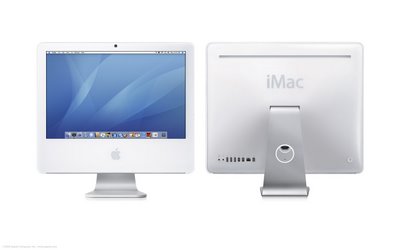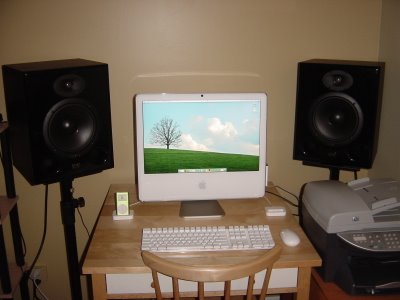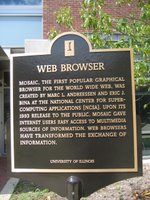
I've always been a very visual, right brain thinker. I feel more comfortable contemplating ideas and working in spaces that are more open, organic and designed simply. At work, when I create reports, emails and presentations they are simple, bullet pointed, and clean -- no fluff or extraneous garbage. Even when I wire up my home theater system I'm a fanatic about keeping the spaghetti bowl of connecting wires bundled neatly, coiled properly out of sight, hardware components stacked and lined up precisely. When I was a kid, I loved coloring within the lines, but not because I didn't want to 'break the rules'. Rather, I liked things that were smooth, uniform, uncluttered, clean. I'm the same way as an adult. Keep it clean, keep it simple, keep it open. That's my motto.
It's taken me a long time to jump the fence when it came to my choice in personal computers, but finally it's happened. I've joined the cult of mac! Hallelujah!
[Disclaimer: that's not me up there, no need to worry, family. Hmm...I do have a haircut coming up though, and I'd love the chance to out do my cousin Kyle and his new haircut....]
I've long since been a Microsoft Windows user, but have always gazed longingly through the window (pun intended) at the ingeniously designed, clean and simple interface and programming code packed in some of the best built machines on the planet. After holding my breath for what seemed like a lifetime, I finally ordered my dream machine, a 20" iMac. Even before booted it up for the first time, I encountered a big part of the Apple experience. I smiled widely at the clean, artfully and carefully designed (yes, designed!) packaging for the machine. I admired how much work and attention to detail was poured into the outer packaging of my new computer. It was immediately evident to me that this is a company that cares about more than just ones and zeroes.
After opening the smooth, delicate clamshell lid, removing the styrofoam insert for the keyboard, the clean white box containing the wireless mouse, software disks and two Apple logo stickers (a 20 year tradition) I unsheathed the pure white face of the machine from it's soft protective white envelope.




That's it, the whole computer. No tower to set up, no external screen to connect. They've taken the concept of an all-in-one solution of a laptop and combined it with the usability of a traditional desktop machine. Even when you remove the cover and see how beautifully the insides are put together, you get a sense that the engineers and designers at Apple care very deeply about the products they build; they take pride in their work. It's well known that the creators of the very first Macintosh back in 1984 all put their names on the inside cover, even though nobody was ever to see them. They considered themselves to be artists, and as such they felt compelled to take pride and ownership in every chip, connection, circuit and fan blade. This spirit lives even today. Every wire, every transistor, every square millimeter of the iMac was logically and cleanly laid out. Click the below image to see the quality up close.

Compare that to what you see when you open up a typical PC:

The size, design and physical aesthetics of the iMac are only one element of its endearing quality, though. The OS X (pronounced "Oh Ess Ten") Tiger operating system follows the same philosophy...nay, mission that the rest of the design has, from the marketing to the packaging to the hardware design: intuitive, fast, clean, and simple. Prompts and on-screen instructions are written in plain English. No wonder Apple is the choice for artists, musicians, and visual thinkers from all walks of life! Windows XP is a great system, but at its heart it's still clunky, complicated (at least as far as the the back end programming code goes), and bloated. And to think, Microsoft has openly copied Apple's OS interface since the first point and click mice were sold in the early 1980's, but still they get it wrong! But let's be honest, most people don't dig down into the programming code of their computers to see how they tick, they just want to point and click, and it's here that you can really see and feel divinity in the details of Apple products.
Little messages guiding us what to do and asking us what we want to do are part of any operating system interface experience, especially with Windows and Apple products. Both can be described as intuitive to an extent, but Apple takes the time to write these messages in simple, plain English like a really helpful, patient friend sitting next to you helping you through a task and asking questions in a conversational tone. These little messages and questions are not the kind of short, choppy often angry little jabs you encounter using Windows. When you use an Apple computer, you get the feeling a lot of thought went into what the messages say. For instance, when I first booted up with my wireless bluetooth keyboard and mouse, I fully anticipated settling in for a lengthy operating system install process with lots of scrolling code and other utilitarian, technical looking stuff, .dll files and the like, all rapidly ticking by robotically as the machine readied itself for duty, much like how a Windows machine would greet its new master. I've installed plenty of Windows operating systems, and although they've gotten better at humanizing the initial boot up process all computers must exectute, they're still light years away from being an enjoyable experience. Not so for the Apple. Instead, after a few seconds of a brief, soothing soft grey screen absolutely barren except for the famous Apple logo a cool animated, sweeping "Welcome!" title sequence began, complete with cool sounding music which greeted me in fourteen languages.
As warm and fuzzy as this message is, it plays only once during the machine's initial boot sequence to introduce itself to me. All that work, to be played only once. That's the point. I'm sure that the sequence code, images and music all took up a lot of room and power to run, which would infuriate a linear, left brained scientific type right down to his pocket protector who might want only the the barest minimum, raw utility from his machine, and in some ways he'd be right in his dismissal. Did it make my day more productive? Did the greeting allow me to crunch an extra few megabytes of data in the same amount of time? No. Nevertheless, for me it was great; a nice touch that made me smile, and that's worth a lot in my book. When I walk into a Starbuck's I enjoy being greeted by a friendly, smiling face and wished a good day when I leave; not a stern, slightly annoyed person who robotically announces the cost of my beverage then deposits it firmly with an expressionless ":NEXT:" when our transaction has concluded. I'm a sucker for warm and fuzzy, I guess, and the Apple definitely delivers in that department.
Next, three or four simple screens walked me through the setup of my new mac. They were written in a laid back, relaxed syntax -- no harsh warnings or stern, complicated commands like I saw installing Windows. (Again, with the warm and fuzzy!) I loved it. Once I glided through the setup process (all of a couple of minutes) I was automatically connected to the WiFi signal broadcast throughout my house, connected to my shared network external hard drive (where we backup all our data) and was on the web in no time.
 There are still some tweaks and adjustments I want to make to tailor my new toy to my liking, and also some new schemas and ways of thinking I need to develop to overcome the deep grooves carved into my brain by Windows over the past decade or so, but so far I can't believe how much better the experience has been. Like Apple fans and devoted programmers everywhere say, it just works. It's so easy that I've begun experimenting with web page design for a family website that will soon have pictures, movies, and who knows what else? You can check it out at voigtfamilynews.com. It's a work in progress, so make sure to bookmark for future reference!
There are still some tweaks and adjustments I want to make to tailor my new toy to my liking, and also some new schemas and ways of thinking I need to develop to overcome the deep grooves carved into my brain by Windows over the past decade or so, but so far I can't believe how much better the experience has been. Like Apple fans and devoted programmers everywhere say, it just works. It's so easy that I've begun experimenting with web page design for a family website that will soon have pictures, movies, and who knows what else? You can check it out at voigtfamilynews.com. It's a work in progress, so make sure to bookmark for future reference!Well, it's time to get back to work. I'm trying hard not to daydream too much, but obviously -- I can't wait to get home tonight to jump back into my warm and fuzzy down comforter of a computer!








